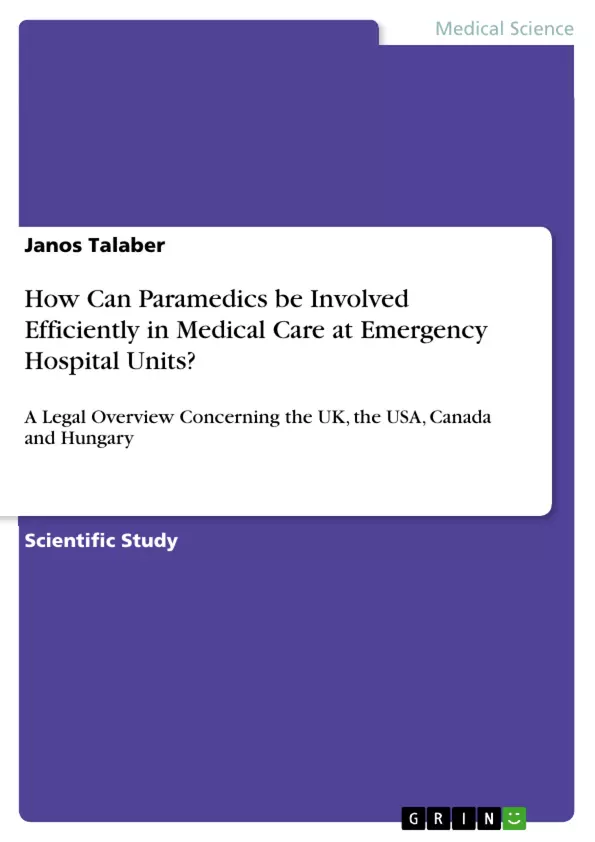This study is concerned with the legal possibilities of how paramedics could be employed and get involved into medical care at emergency hospital units with a specific focus on the situation in Hungary.
It is obvious that there is of lack medical doctors, nurses and other high trained staff not only in hospital wards, but also in emergency care in Hungary. To overlap this lack and hiatus, it was several times noted in Hungary that as for competency reasons, the closest medical staff to be involved in emergency medical treatments is the paramedics.
The accurate scopes of Paramedics, competency and other conditions vary differently in the World, therefore there is not a consequent and primarily accepted competency. However, serving the streets and responding to dispatches is pretty much similar in all over the World, therefore, the main streams are almost totally related.
Throughout this study there will therefore be focus on the scopes and competencies as well as the education strategies of paramedic trainings in Canada, the USA and within the European Union.
Inhaltsverzeichnis (Table of Contents)
- I. Introduction
- II. The scope of Paramedic Science in the USA and Canada
- III. Provincial variations on the National Occupational Competency Profile
- IV. Special types of Paramedics in the USA
- A. Critical care paramedic
- B. Tactical paramedic
- C. Occupational health paramedic
- D. Community paramedic
- E. Incident response paramedic
- F. Paramedic specialist
- G. Infant transport team paramedic
- V. Laws for Paramedics in the UK
- VI. The history and structure of ambulance care in Hungary
- A. Institutional structure
- B. Ambulance station network
- VII. Act 18/2016 Hungarian Competency Act of Health Care Workers
- A. About the Act
- B. General skills
- a. Knowledge
- b. Abilities
- c. Attitude
- d. Autonomy and Responsibility
- C. Common Competencies in Nursing and Patient Treating Professionals (7.1.1.)
- D. Special skills and knowledge of Paramedics
- VIII. Charts and Other Characteristics
- IX. Conclusions
Zielsetzung und Themenschwerpunkte (Objectives and Key Themes)
This study aims to explore the legal possibilities of employing paramedics in hospital emergency rooms. It focuses on the potential of integrating paramedics into medical care at emergency units, addressing the shortage of medical professionals in both hospital wards and pre-hospital emergency care.
- Legal framework for off-board paramedic employment in the UK, USA, Canada, and Hungary
- Scope and competencies of paramedic science in different countries
- Variations in education and training for paramedics
- Role of paramedics in pre-hospital and hospital emergency care
- Comparison of paramedic training and practice across different regions.
Zusammenfassung der Kapitel (Chapter Summaries)
The introduction lays out the study's purpose, which is to investigate the legal possibilities of utilizing paramedics outside of their traditional ambulance setting, specifically in hospital emergency rooms. It highlights the shortage of medical professionals and argues that paramedics are well-positioned to address this gap due to their skills and competency.
Chapter II delves into the scope of paramedic science in the USA and Canada, highlighting the growing trend of integrating paramedics into emergency rooms to provide patient care in collaboration with other healthcare professionals. It also explores the movement towards self-regulation among Canadian paramedics.
Chapter III discusses provincial variations in the National Occupational Competency Profile in Canada, providing a detailed overview of the different approaches to paramedic training and practice across various regions.
Chapter IV explores various specialized types of paramedics in the USA, including critical care paramedics, tactical paramedics, occupational health paramedics, community paramedics, incident response paramedics, paramedic specialists, and infant transport team paramedics.
Chapter V examines the legal framework for paramedics in the UK, providing insights into the regulations and policies governing their practice.
Chapter VI delves into the history and structure of ambulance care in Hungary, examining the institutional structure and ambulance station network in the country.
Chapter VII focuses on Act 18/2016 Hungarian Competency Act of Health Care Workers, providing a comprehensive analysis of the law's provisions related to general skills, common competencies, and special skills and knowledge required for paramedics.
Schlüsselwörter (Keywords)
This study focuses on the legal framework, competency, and training of paramedics in the context of their potential involvement in hospital emergency rooms. Key keywords include: off-board paramedics, paramedic science, emergency medicine, hospital emergency units, legal framework, competency, training, pre-hospital care, healthcare professionals, medical law, and international comparisons.
- Citation du texte
- Janos Talaber (Auteur), 2018, How Can Paramedics be Involved Efficiently in Medical Care at Emergency Hospital Units?, Munich, GRIN Verlag, https://www.grin.com/document/454127



